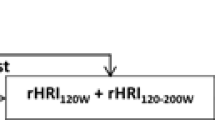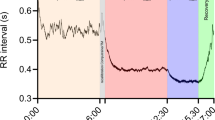Abstract
Heart rate recovery is an indirect marker of autonomic function and changes therein may offer a practical way of quantifying the physiological effects of training. We assessed whether per cent heart rate recovery (HRr%) after a standardized sub-maximal running (Heart rate Interval Monitoring System: HIMS) test, changed with acute changes in training load. A total of 28 men and women (mean age 30 ± 5 years) trained ad libitum for 2 weeks during which their heart rate (HR) was recorded. Training load was quantified using Training Impulse (TRIMPs). The participants were grouped based on whether they increased (Group I, n = 9), decreased (Group D, n = 8) or kept their training load constant (Group S, n = 11) from week 1 to week 2. Each week, the subjects completed a HIMS test. Changes between weeks in HR at the end of the test and HRr% were compared between groups. Mean per cent change in TRIMPs from week 1 to week 2 was significantly different among the groups (Group I, 55 ± 21% vs Group S, −6 ± 6% vs Group D, −42 ± 16%; P < 0.05). Group I had a slower HRr% and Group D tended to have a slightly faster HRr% after HIMS 2 than after HIMS 1 (mean per cent change 5.6 ± 8.7 vs −2.6 ± 3.9; P = 0.03). Thus a negative effect on HRr was observed with increases in training load. Sub-maximal HR was not affected by acute changes in training load. Whereas HR during exercise measures cardiac load, HRr may reflect the state of the autonomic nervous system, indicating the body’s capacity to respond to exercise.



Similar content being viewed by others
References
Achten J, Jeukendrup AE (2003) Heart rate monitoring: applications and limitations. Sports Med 33:517–538
al Ani M, Munir SM, White M, Townend J, Coote JH (1996) Changes in R–R variability before and after endurance training measured by power spectral analysis and by the effect of isometric muscle contraction. Eur J Appl Physiol Occup Physiol 74:397–403
Altman DG (1991) Practical statistics for medical research. Chapman and Hall, London
Aubert AE, Seps B, Beckers F (2003) Heart rate variability in athletes. Sports Med 33:889–919
Banister EW (1991) Modeling elite athletic performance. In: MacDougall JD, Wenger HA, Green HJ (eds) Physiological testing of the high-performance athlete. campaign (IL) Human Kinetics Books, pp 403–425
Bonaduce D, Petretta M, Cavallaro V, Apicella C, Ianniciello A, Romano M, Breglio R, Marciano F (1998) Intensive training and cardiac autonomic control in high level athletes. Med Sci Sports Exerc 30:691–696
Brynteson P, Sinning WE (1973) The effects of training frequencies on the retention of cardiovascular fitness. Med Sci Sports 5:29–33
Bunc V, Heller J, Leso J (1988) Kinetics of heart rate responses to exercise. J Sports Sci 6:39–48
Carter JB, Banister EW, Blaber AP (2003a) Effect of endurance exercise on autonomic control of heart rate. Sports Med 33:33–46
Carter JB, Banister EW, Blaber AP (2003b) The effect of age and gender on heart rate variability after endurance training. Med Sci Sports Exerc 35:1333–1340
Charlton GA, Crawford MH (1997) Physiologic consequences of training. Cardiol Clin 15:345–354
Houmard JA, Kirwan JP, Flynn MG, Mitchell JB (1989) Effects of reduced training on submaximal and maximal running responses. Int J Sports Med 10:30–33
Iwasaki K, Zhang R, Zuckerman JH, Levine BD (2003) Dose–response relationship of the cardiovascular adaptation to endurance training in healthy adults: how much training for what benefit? J Appl Physiol 95:1575–1583
Jeukendrup AE, Hesselink MK, Snyder AC, Kuipers H, Keizer HA (1992) Physiological changes in male competitive cyclists after 2 weeks of intensified training. Int J Sports Med 13:534–541
Kannankeril PJ, Le FK, Kadish AH, Goldberger JJ (2004) Parasympathetic effects on heart rate recovery after exercise. J Investig Med 52:394–401
Lambert MI, Borresen J (2006) A theoretical basis of monitoring fatigue: a practical approach for coaches. Int J Sports Sci Coach 1:371–388
Lamberts RP, Lemmink KAPM, Durandt JJ, Lambert MI (2004) Variation in heart rate during submaximal exercise: implications for monitoring training. J Strength Cond Res 18:103–107
Levy WC, Cerqueira MD, Harp GD, Johannessen KA, Abrass IB, Schwartz RS, Stratton JR (1998) Effect of endurance exercise training on heart rate variability at rest in healthy young and older men. Am J Cardiol 82:1236–1241
Loimaala A, Huikuri H, Oja P, Pasanen M, Vuori I (2000) Controlled 5-mo aerobic training improves heart rate but not heart rate variability or baroreflex sensitivity. J Appl Physiol 89:1825–1829
MacMillan JS, Davis LL, Durham CF, Matteson ES (2006) Exercise and heart rate recovery. Heart Lung 35:383–390
Mahon AD, Anderson CS, Hipp MJ, Hunt KA (2003) Heart rate recovery from submaximal exercise in boys and girls. Med Sci Sports Exerc 35:2093–2097
Mazzeo RS (1991) Catecholamine responses to acute and chronic exercise. Med Sci Sports Exerc 23:839–845
Meeusen R, Duclos M, Gleeson M, Rietjens G, Steinacker J, Urhausen A (2006) Prevention, diagnosis and treatment of the overtraining syndrome. Eur J Sports Sci 6:1–14
Meeusen R, Piacentini MF, Busschaert B, Buyse L, De Schutter G, Stray-Gundersen J (2004) Hormonal responses in athletes: the use of a two-bout exercise protocol to detect subtle differences in (over)training status. Eur J Appl Physiol 91:140–146
Melanson EL, Freedson PS (2001) The effect of endurance training on resting heart rate variability in sedentary adult males. Eur J Appl Physiol 85:442–449
Michael E, Evert J, Jeffers K (1972) Physiological changes of teenage girls during five months of detraining. Med Sci Sports 4:214–218
Mujika I, Padilla S, Pyne D, Busso T (2004) Physiological changes associated with the pre-event taper in athletes. Sports Med 34:891–927
Noakes TD, Myburgh KH, Schall R (1990) Peak treadmill running velocity during the VO2 max test predicts running performance. J Sports Sci 8:35–45
O’Connor PJ, Crowley MA, Gardner AW, Skinner JS (1993) Influence of training on sleeping heart rate following daytime exercise. Eur J Appl Physiol Occup Physiol 67:39–42
Otsuki T, Maeda S, Iemitsu M, Saito Y, Tanimura Y, Sugawara J, Ajisaka R, Miyauchi T (2007) Postexercise heart rate recovery accelerates in strength-trained athletes. Med Sci Sports Exerc 39:365–370
Pierpont GL, Voth EJ (2004) Assessing autonomic function by analysis of heart rate recovery from exercise in healthy subjects. Am J Cardiol 94:64–68
Savin WM, Davidson DM, Haskell WL (1982) Autonomic contribution to heart rate recovery from exercise in humans. J Appl Physiol 53:1572–1575
Shetler K, Marcus R, Froelicher VF, Vora S, Kalisetti D, Prakash M, Do D, Myers J (2001) Heart rate recovery: validation and methodologic issues. J Am Coll Cardiol 38:1980–1987
Short KR, Sedlock DA (1997) Excess postexercise oxygen consumption and recovery rate in trained and untrained subjects. J Appl Physiol 83:153–159
Skinner JS, Gaskill SE, Rankinen T, Leon AS, Rao DC, Wilmore JH, Bouchard C (2003) Heart rate versus %VO2max: age, sex, race, initial fitness, and training response—HERITAGE. Med Sci Sports Exerc 35:1908–1913
Smith DJ, Roberts D (1994) Effects of high volume and/or intense exercise on selected blood chemistry parameters. Clin Biochem 27:435–440
Sugawara J, Murakami H, Maeda S, Kuno S, Matsuda M (2001) Change in post-exercise vagal reactivation with exercise training and detraining in young men. Eur J Appl Physiol 85:259–263
Swaine IL, Linden RJ, Mary DA (1994) Loss of exercise training-induced bradycardia with continued improvement in fitness. J Sports Sci 12:477–481
Tulppo MP, Hautala AJ, Makikallio TH, Laukkanen RT, Nissila S, Hughson RL, Huikuri HV (2003) Effects of aerobic training on heart rate dynamics in sedentary subjects. J Appl Physiol 95:364–372
Tulppo MP, Makikallio TH, Seppanen T, Laukkanen RT, Huikuri HV (1998) Vagal modulation of heart rate during exercise: effects of age and physical fitness. Am J Physiol 274:H424–H429
Urhausen A, Gabriel H, Kindermann W (1995) Blood hormones as markers of training stress and overtraining. Sports Med 20:251–276
Urhausen A, Kindermann W (2002) Diagnosis of overtraining: what tools do we have? Sports Med 32:95–102
Uusitalo AL, Uusitalo AJ, Rusko HK (1998) Exhaustive endurance training for 6–9 weeks did not induce changes in intrinsic heart rate and cardiac autonomic modulation in female athletes. Int J Sports Med 19:532–540
Uusitalo ALT (2001) Overtraining: making a difficult diagnosis and implementing targeted treatment. Phys Sportsmed 29:35–50
Williams JG, Eston RG (1989) Determination of the intensity dimension in vigorous exercise programmes with particular reference to the use of the rating of perceived exertion. Sports Med 8:177–189
Wilmore JH, Stanforth PR, Gagnon J, Leon AS, Rao DC, Skinner JS, Bouchard C (1996) Endurance exercise training has a minimal effect on resting heart rate: the HERITAGE Study. Med Sci Sports Exerc 28:829–835
Wilmore JH, Stanforth PR, Gagnon J, Rice T, Mandel S, Leon AS, Rao DC, Skinner JS, Bouchard C (2001) Heart rate and blood pressure changes with endurance training: the HERITAGE family study. Med Sci Sports Exerc 33:107–116
Yamamoto K, Miyachi M, Saitoh T, Yoshioka A, Onodera S (2001) Effects of endurance training on resting and post-exercise cardiac autonomic control. Med Sci Sports Exerc 33:1496–1502
Zavorsky GS (2000) Evidence and possible mechanisms of altered maximum heart rate with endurance training and tapering. Sports Med 29:13–26
Acknowledgments
The research undertaken in this study was funded in part by the University of Cape Town, Discovery Health, National Research Foundation, Ernst & Ethel Eriksen Foundation and Deutscher Akademischer Austausch Dienst.
Author information
Authors and Affiliations
Corresponding author
Rights and permissions
About this article
Cite this article
Borresen, J., Lambert, M.I. Changes in heart rate recovery in response to acute changes in training load. Eur J Appl Physiol 101, 503–511 (2007). https://doi.org/10.1007/s00421-007-0516-6
Accepted:
Published:
Issue Date:
DOI: https://doi.org/10.1007/s00421-007-0516-6




